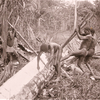Children on the Fault Lines: A Historical-Anthropological Reconstruction of the Background of Children purchased by Dutch Missionaries between 1863 and 1898 in Dutch New Guinea
DOI:
https://doi.org/10.18352/bmgn-lchr.10876Abstract
This case study aims at looking behind the construal of imperialism as ‘white people saving brown children from brown people’ by reconstructing the reasons why locally enslaved children became available for missionaries of the Utrechtsche Zendingsvereeniging (UZV) to purchase in Dutch New Guinea between 1863 and 1898. This analysis shows that, contrary to what the missionaries often claimed, children within local communities in the area of the Bird’s Head, Cenderawasih Bay and Biak-Numfoor islands were carefully raised to become part of the complex gift-kinship-systems of their people. However, some children, as well as adults, had the misfortune to live on the fault lines of competing or conflicting communities. Children were probably sold to repair systematic differences in power and wealth between inland and coastal peoples. Especially children who were already in a weak position – orphans, or children who became related to sorcery – were the first ones to be sold. Within local communities, after they were given away, sold or captured, children could be kindly adopted within another family, exploited to work the land, further traded or used in negotiations. Precisely during the first decades of the missionaries’ presence, the tensions and violence between inland and coastal communities raised, due to an uncontrolled boom in the hunt and trade of birds of paradise. This international market thus augmented those fault lines that ‘produced’ children for local slave markets, and, in the end, for missionaries to purchase. The missionaries themselves could only buy these children within the rationale of yet another ‘economy’: a western Christian-humanitarian economy in which the missionary ‘redemption’ of locally enslaved children raised money and support for the missions back home.
De Utrechtsche Zendingsvereeniging (UZV) rechtvaardigde haar aanwezigheid aan de noordkust van Nederlands Nieuw-Guinea tussen 1863 en 1898 onder andere door lokaal tot slaaf gemaakte kinderen vrij te kopen, oftewel, door ‘bruine kinderen te redden van bruine mensen’. Dit artikel probeert te reconstrueren wat er achter dat beeld schuilging: hoe kwam het dat kinderen aan de zending te koop werden aangeboden? Dit artikel toont eerst aan dat kinderen uit deze regio’s van Bird’s Head, Cenderawasih Bay en de Biak-Numfoor-eilanden, anders dan de missionarissen beweerden, zorgvuldig binnen hun lokale gemeenschappen werden opgevoed en in specifieke gift-verwantschapssystemen werden opgenomen. Vervolgens wordt gereconstrueerd hoe en waarom sommige kinderen, net als sommige volwassenen, terecht kwamen op de breuklijnen tussen verschillende gemeenschappen die met elkaar in competitie of in conflict waren. Kinderen werden wellicht door hun eigen gemeenschap verkocht om onevenwichtige machtsverhoudingen tussen groepen die in het binnenland en aan de kust leefden te herstellen. Met name kinderen die al in een zwakkere positie verkeerden – wezen of kinderen die in verband werden gebracht met tovenarij – werden het eerst verkocht. Nadat ze waren verkocht of geroofd werden kinderen soms in hun nieuwe gemeenschap geadopteerd, maar soms ook uitgebuit en vaak weer verhandeld. De zendelingen vestigden zich in Nieuw- Guinea juist op het moment dat de jacht op en de handel in paradijsvogels ongecontroleerd toenamen. Deze internationale markt versterkte de breuklijnen en de gewelddadige spanningen tussen de lokale gemeenschappen, waardoor er meer kinderen op de lokale markt voor slaven terecht kwamen, en er uiteindelijk ook meer kinderen aan de missionarissen te koop werden aangeboden. De missionarissen zelf konden deze kinderen alleen verwerven binnen de logica van een ander soort ‘economie’, namelijk een westerse, christelijk-humanitaire gifteconomie waarin het ‘vrijkopen’ van deze tot slaaf gemaakte kinderen waardevol bleek voor een toenemende Nederlandse fondsenwerving en steun voor de zending in Nieuw-Guinea.
Downloads

Published
Issue
Section
License
Copyright (c) 2021 BMGN - Low Countries Historical Review

This work is licensed under a Creative Commons Attribution-NonCommercial 4.0 International License.
Authors who publish with this journal agree to the following terms:
a) Authors retain copyright and grant the journal right of first publication with the work simultaneously licensed under a Creative Commons Attribution 4.0 International (CC BY 4.0) that allows others to share the work with an acknowledgement of the work's authorship and initial publication in this journal.
b) Authors are able to enter into separate, additional contractual arrangements for the non-exclusive distribution of the journal's published version of the work (e.g., post it to an institutional repository or publish it in a book), with an acknowledgement of its initial publication in this journal.
c) Authors are permitted to post their work online (e.g., in institutional repositories or on their website) prior to and during the submission process.
Authors are explicitly encouraged to deposit their published article in their institutional repository.







